|
Gathering
Martin Holman responds to 'Gathering' at Gray's Wharf,
Penryn, 28.5.21 - 13.6.21
The word ‘Gathering’ is an unlikely provocation. In normal times a
gathering is a common event, often with specific intentions, a family
celebration maybe or an assembly with religious or political purposes.
And it is an occasion usually looked forward to with pleasure.
But that is in normal times. In the inescapable context of the global
health pandemic, however, the invitation for people and objects to come
together in one place and share an experience collectively is greeted
with alarm, certainly with apprehension. After all, for months just
about every inter-personal activity outside the family has been
restricted by a non-coercive democratic state exercising the force of
law. Only subversives challenge that state of affairs.
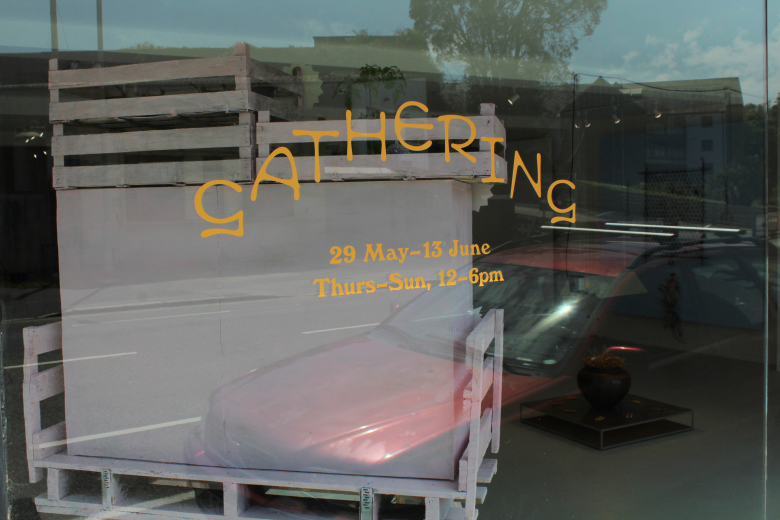
The people behind this exhibition with a title that makes the heart race
might fit the description of a subversive, at least generically. They
are, after all, artists, members of a community of habitual social
inquisitors in any context at any time. The ten participating artists,
all based in west Cornwall, responded to the invitation from two of
their number, Verity Birt and Jonathan Michael Ray, to ‘explore the act
of gathering and its value today after a year of travel restrictions and
social isolation’. Art does not thrive in a bubble or what is known in
COVID times as a 'minimised risk environment'. So, the opening of this
show’s fortnight run in Penryn marked the arrival of that point on the
government’s road map out of lockdown when mixing in England was
cautiously relaxed. Non-commercial galleries had re-opened, and guests
needed bring nothing but themselves and being prepared to interrogate.
And, of course, they needed a face covering.
The organisers provided the nourishment. Not only did the show succeed
in hydrating the spirit after a drought in the galleries of the
south-west, 'Gathering' also wove its theme in and around the gallery
through individual works laid out with care and intelligence.
Relationships arose in formal associations as well as via cultural
coincidences, with the area’s folkloric traditions a common allusion.
Each artist made a single contribution so that the works felt in touch
with the time and in touch with each other. Each piece was an offering
in mind and body to the visitor who could walk away physically refreshed
and mentally reanimated.
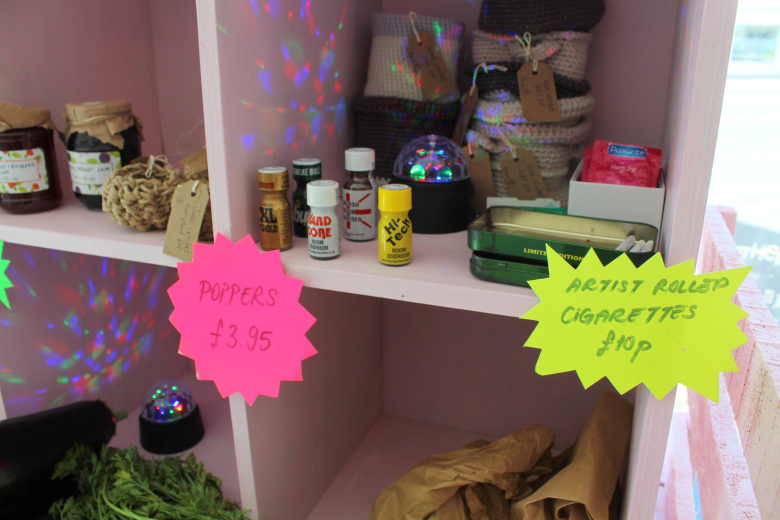
Ilker Cinarel: Honesty Box (detail)
Ilker Cinarel’s 'Honesty Box' captured the theme directly with a wooden
stall of the type encountered on roadsides and at farm gates, stocked
with fresh produce on sale to every passer-by. When much art reflects
the cynicism rife in the commodification of increasing amounts of
contemporary life, Cinarel latches on to the trust that holds society
together, a quality that has been affirmed, tried and tested (but not
tracked) during the era of the virus. Unlike the sober reality of farm
shops, Cinarel’s stock lines ran beyond the culinary staples of
cucumbers, potatoes, courgettes and local home-made jam. Those rural
essentials were all there but so too were items that pointed hopefully
towards future, undistanced liaisons: artist-rolled cigarettes,
exotically branded condoms and a selection of bottled amyl nitrates.
Where does a stall with such good-natured intention and festive
demeanour deserve to be sited? Fronted by the eponymous honesty box
itself, painted pink and embellished with glitter and disco balls, it
should establish a new norm of pop-up retail. This was remote selling at
its most affable, with discretion not entirely assured.
Matching Cinarel’s warmth and humour was Georgia Gendall who foresaw
popular anticipation of the return to outdoor pastimes by proposing
participation in the 'Penryn Worm Charming Championship'. ‘Worm
charming’ is a recognised competitive sport – at least in east Texas,
according to Wikipedia. The same source also divulges that homo sapiens
is not the only species to ‘grunt’ or ‘fiddle’ the worm. Gulls do it and
even wood turtles stamp their feet while doing it. But among humans the
skill is at risk of dying: that creative being has developed easier and
more industrial methods of coaxing earthworms destined for the
fisherman’s hook out of the ground. Nonetheless, festivals in Devon and
Canada attest to the survival of the ‘stob’ and ‘rooping iron’ to
‘twang’ the soil, if only in the cause of entertainment. Penryn can be
added to the roll call because Gendell was promoting a gathering of her
own, scheduled for a rural location a fortnight after the show’s
closure. This thoughtful gesture to keep the communal spirit glowing
projected the visitor’s widening horizons towards another place in the
near future to banish the worst of lockdown woe into memory. The artist
connected the visitor with the event through a QR code to scan: a
virtual space tacked on to the real one of the gallery. The incentive?
If the prospect of gathering was not enough, the glazed ceramic objects
in the gallery itself, palm-sized and worm-like, were offered as
trophies on their slow approach to the winning competitors.
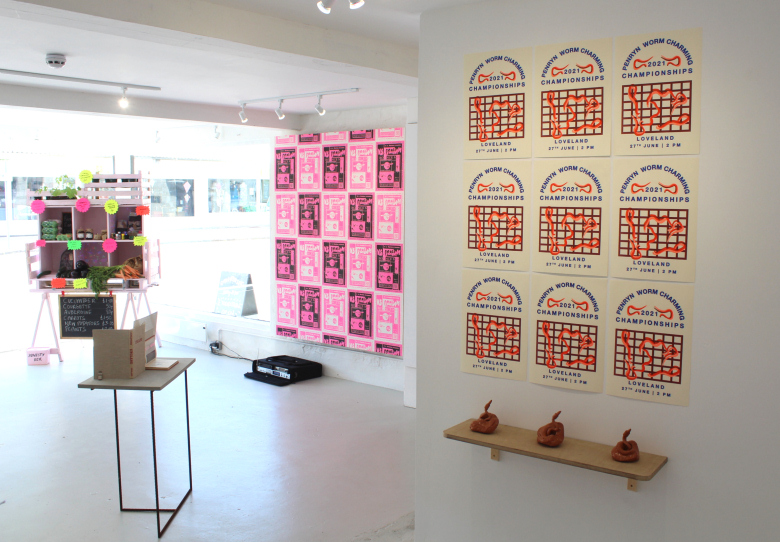
Georgia
Gendall: Penryn Worm Charming Championships (foreground) Simon
Bayliss: WS Graham Bounce Mix (background)
Both Cinarel and Gendall anticipate directly people getting together;
the presence of unseen others is clearly implied by their work, their
absence only temporary but almost palpably sensed. The same is felt in
Simon Bayliss’s installation, which is also opened up by QR code from a
wall of posters into an additional space accessed through headphones.
And as with the previous two artists, whose work is wide-ranging in
media and embraces the absurd and the communal, Bayliss’s mix of print
and music here reflected his established practice, one which also
extends into pottery and performance. All the contributions to the show
can be considered typical of what the artists do or, more accurately,
the idioms they engage with as part of several parallel and linked
strands that make up their careers. With Bayliss, that spread of
activity is the material that builds bridges between ways of making. A
common feature is the word, spoken, written and sung, as substitute for,
and in juxtaposition with, the image. The textural variety is conceptual
and material, from bulky clay to spikey, linear soundscapes in a redrawn
artfulness. His choice of mixing W S Graham, the Scottish-born poet who
settled in St Ives, with modern dance music tracks effectively recasts
the context in which the poet’s work is usually encountered. Bayliss
also draws on a creative figure from the recent past who complements
this artist’s own co-operative spirit. Graham’s output flowed between
idioms, seeking to make bridges between poetry and painting, for
instance.
Admired by Dylan Thomas and T.S. Eliot, Graham was a point of contact
between neo-Romantic and modernist currents in mid-century British art.
On one occasion Graham asked fellow diners at the Gurnard’s Head in
Zennor to mimic the sound of a raging gale. Indeed, metaphors for
weather often drive his narrative poetry, which gains momentum like the
onset of a storm at sea, then slows the way a storm subsides. For 'W S
Graham Bounce Mix', Bayliss punctuates the mixed tape of dance music
tracks with the words of Graham’s poems which he speaks against a
background of sound, like the ghost of Graham’s impromptu choir. One
poem is titled ‘Five Visitors to Madron’, a COVID bubble ahead of its
time. In ‘Two Poems on Zennor Hill’ Graham exhibited an interest in
wordsmithing as rich as contemporary DJs’ explorations of fresh sounds
and mixes. And location as a subject was as important to Graham as it
seems to be to Bayliss, although with different outcomes. For Bayliss
the spiritually unifying urban arena of the techno dancefloor is as
energising as the wilderness of the Penwithian moors, heritage of stone
quoits and turbulence of air, land and sea.
Music and language are about communication. Graham enjoyed being
‘assailed by our acquaintances and a friend here and there’ among St
Ives artists once he moved to Cornwall in his twenties; he thrived in
the company of others and, one senses, he would have enjoyed the
dynamism and passion of the rave scene. For perhaps his most famous
work, 'The Nightfishing' (1955), a night in a herring boat out on the
North Sea, Graham made use of the ancient musical rhythms in bardic
poetry. At any time, he revelled in a sea of words, in rackety phrases
and concatenating combinations of adjectives. Above all he primed
metaphors where the appearance of reality is turned with craftsmanship
into the sweeping arc of the imagination.
As in Verity Birt’s 'Brackish Rite (votive offerings to the Penryn
River)' which manifests itself in the gallery as a coracle beached on
the gallery floor. Long coloured ribbons tied around the wildflower
bouquet sprouting at the apex of willow rods arching over the boat’s
interior, stream out over the concrete floor in imitation of ripples on
water that have caught the light. Birt constructed the single-person
vessel using traditional techniques so that, as with Gendall and her
worming event, the work assumed an element of preservationist zeal. As
an object out of place, the coracle resonated with its temporary siting
in an intriguing fashion that amplified its presence from dark-coloured
woven basket into a single relic snatched from its context to stand for
an entire cultural system in a museum.
At first it appeared beautifully
melancholic as the gift brought to the party and soon abandoned. Because
mystery gathered round its presence, its components percolated into
several consecutive narratives before brewing into its actual purpose,
prompted by the reference in its title, to the ‘Brackish rite’ itself,
another performance planned for the last day of the show at the point on
the Penryn river, where fresh water meets the sea.
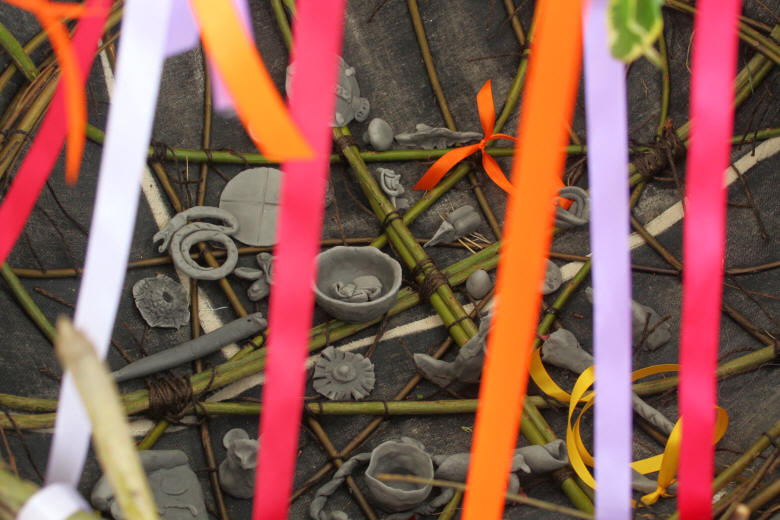
Verity Birt: Brackish Rite (votive offerings to the
Penryn River) (detail)
Birt’s contribution fulfilled two briefs running through the show. The
first spanned definitions of gathering, to which Birt applied the ritual
significance. The second related to a pre-existing text available to
visitors in a bespoke edition at the entrance. This risographed booklet
reproduced the essay that offered a redefinition of human evolution,
first published in 1986 by the American master of speculative fiction,
Ursula K. Le Guin. Called ‘The Carrier Bag Theory of Fiction’, this
story supposes that before the human species made sticks into swords to
hunt with and kill, ‘the tool that forces energy outward’, ‘we made the
tool that brings energy home’. Thus, the ancient ancestors of today’s
populations first of all invented the container, a constructive tool
that brought beneficial items to the home or the shrine, that is, the
setting for whatever is sacred. The forerunner of the modern utilitarian
carrier is exalted, in Le Guin’s words, as ‘the bag of stars’.
Le Guin’s proposition had most relevance to Birt. Visitors were invited
to model votive objects of their own with the materials that the artist
provided. They were then asked to consign their creations to the boat’s
interior as it sat in the gallery like a large basket in order for them
to be incorporated into the rite performed on the river when the coracle
set out on the water. But Le Guin’s text has a wider meaning: it
formulates a metaphor for the act of storytelling. Not only is the
pursuit of narrative integral to the critical process of interpretation
of art works, it is also the product of imagination, the faculty at the
core of being human. Le Guin meditates on a vision of the evolutionary
sequence that places collective holding and sharing before aggressive
dominance. Storytelling is a communal act of sharing. As such it sits
well within this exhibition; to a lesser or greater degree, all artists
figure out different realities through making, paralleling Le Guin whose
constructive medium was writing.
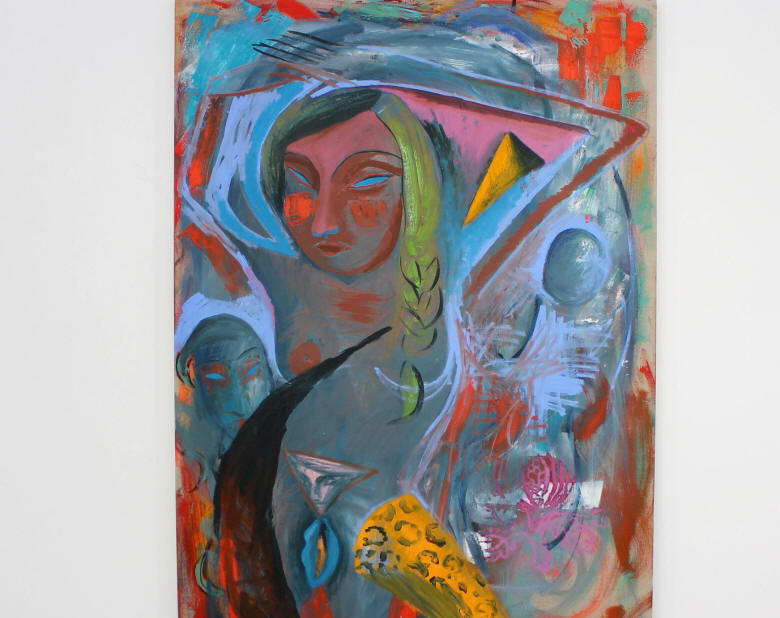
Lucy Stein:
Becoming Boscawen Un (detail)
The figures, palette and compressed space of 'Becoming Boscawen Un'
negotiates several mythic storylines consecutively. The large-scale
painting by Lucy Stein relates to her long-standing interest in the
sacred sites of West Cornwall and their ancient origins. Stein also
works with ceramics, film and performance in a manner that relates her
sources to the present and to contemporary artistic and political
themes. Most clearly cited in the present work is the so-called
primitivism in Picasso’s images from that period of his career around
1907 when he revolutionised western painting by discarding traditions of
beauty and compositional unity and importing conventions from Asian and
African art, that is, from cultures then regarded as colonised and
inferior. Within that language Stein presents a confrontation with
assured but only half-recognised female figures who look confidently out
of the picture’s space and into the gallery, namely the visitor’s
domain. The congested atmosphere is almost incantatory; bodies weave in
and around the interior space as if summoned by an unseen narrator.
Stein draws upon Penwith’s pagan heritage of matriarchal religion in
which goddesses of the moon, fertility, the setting sun were worshipped.
Boscawen-un is a Bronze Age stone circle near the town of St Buryan
associated with the bard, or storytelling tradition in Cornwall, and
mentioned as an arena for poetry in early medieval Welsh texts. On its
arrival Christianity subsumed these legends into its own hierarchy of
the virtuous, merging goddesses with its saints in a celestial order
dominated by a single godhead revealed as three divine personalities,
two of which are assumed male (and the third might be) below whom ranks
its own Mother Goddess figure, Mary, the mother of Jesus. Not that
Cornish regard for the pagan past was entirely overturned; rather, its
beliefs were concretised in myths about the origins of standing stones,
for instance, and folklore about the transgressive force attached to
witches and the occult.
The gathering depicted by Jonathan Michael Ray is, by its title, a 'Holy
Reunion'. Since the time of Rembrandt and Hals, reunions have been
commemorated by group portrayals, the arrangement of which grew steadily
more formalised once the medium of depiction was assumed by photography.
The Victorians perfected the stiff poses of unrelaxed faces turned to
the front, united in common purpose; and it went without saying in those
days that the faces were most often male. The assembly in Ray’s
composition, by contrast, conveys an atmosphere of doubt or urgent
confusion. Do the participants know why they are gathered in that place?
Or, having accepted the invitation, have they missed the point of it?
Heads look this way and that, and sightlines cross. They look everywhere
except upwards to the pair of feet just visible at the image’s topmost
edge. The detail is easily missed but appears significant. Do those feet
precipitate a landing or the owner’s ascent, or a third possibility
which is the execution of a truly spectacular feat of self-levitation
and hover to be followed by a return to earth?
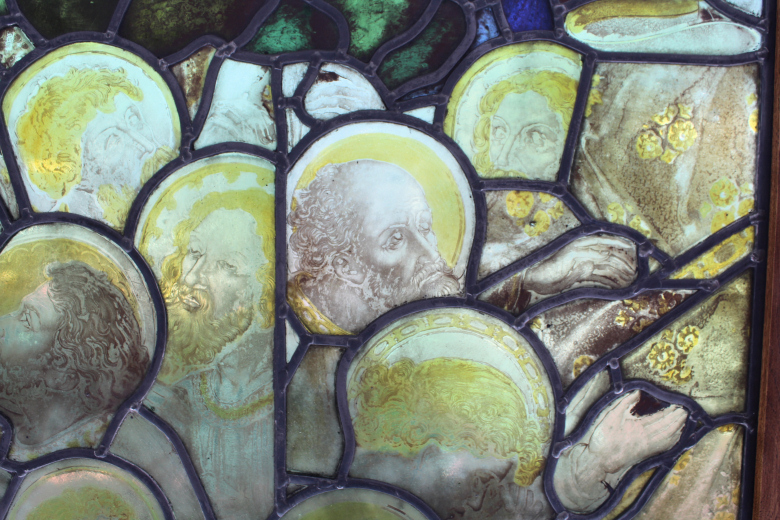
Jonathan Michael
Ray: Holy Reunion (detail)
Ray’s route to possible meanings assumes the language of ecclesiastical
stained or coloured glass. Every part of the composition is anchored
into place by lead seams, an historicism that arrests the frisson of
alarm in the viewer of early summer 2021 who is by now drilled into the
discipline of two-metre distancing. The immediate association of the
image is with Biblical illustration, the holy communion of souls, of
hosts in Heaven and the community of saints. But that does quite fulfill
the possibilities in this case, in spite of the proliferation of
halo-like headwear among the men. The stained-glass medium has acquired
increasingly secular uses over the centuries and perhaps is most often
seen, religious buildings aside, in homes and offices. Ray rescues old
glass; he sources examples online that come from all types of place but
most comes from chapels and churches. He acquires the glass as raw
material, giving it new purposes by mixing fragments in need of
restoration into a story of his own. The potential is obvious and the
directions it can take, formally and conceptually, are numerous even
within the limitations that so many superannuated saint figures create.
The audience’s collective assumptions might tend towards the obvious
interpretation of a faith-based narrative – and Ray, interestingly,
applies the adjective ‘holy’ to the title. But even that word has gained
a richness of usage that is not entirely devotional, as Batman’s Robin
can attest. So Ray responds with a question to the viewer about how far
assumptions can be trusted.
Narrative is not exempt from any part of this exhibition; no artwork
relies entirely on non-objective attributes of line, form, colour, space
and time. The wall-mounted works by Tom Sewell and Dan Howard Birt
gather elements into assembled compositions in rebus fashion to unlock
narratives of meaning to a visitor investing time to achieve an
interpretation. Sewell’s 'Sunrise ’21 (Deep Field)' is the most
cohesive. In a sense, it resembles a traveller’s record of place and
experience triggered by tokens. The type of transit, however, is left
sufficiently open within the work itself for an onlooker to fill gaps.
(The free gallery guide offers the artist’s viewpoint although
compliance is not mandatory.) This work picks up from Birt’s coracle
situated next to it, since both call upon associations with folk art as
the genre chosen by highly skilled people wishing to express their
creative urges, for whatever reason, outside artistic conventions. The
diaristic feel of Sewell’s collage of disparate finds in the landscape,
from shoreline driftwood, rope, shells and stones to pewter objects and
an onion, is pulled together with graphic clarity on a rectangle of
meshed fencing placed over a sky-blue ground applied to the wall. The
mesh is stretched between willow poles: the imitation of painting, the
historic portal to illusion, might be coincidental, just as the
suggestion of a page seems apt, for literary overtones exist here.
As they do in Howard Birt polyptych of
painted supports – canvas, calico and wood panel: a brief history of
painting. The surfaces carry emblems and lettering, from the largest
which spells ‘H’m’ to a side column of legible phrases derived from
writings by artists and poets to which the gallery guide provides a
quick key. It mentions Graham Sutherland writing about Picasso, a line
from T.S. Eliot’s stream-of-conscious early poetry, and an expression
coined by the Welsh priest and poet R.M. Thomas. Finally, Giotto is the
source of flaming rock on the big canvas and, conceivably, the title,
'Trial by Fire'. Actually, the work brings to mind the recurrent history
of making any painting; the deliberation and doubt, the borrowings
(unattributed offerings?) and pilfering from other artists that go into
the creative ‘mulch’ that Howard Birt refers to in a statement. From
that compost springs another picture in the author’s inimitable style,
one that balances precariously between adequacy and, as epitomised by
the allusion to Eliot’s arguably love-struck J. Alfred Prufrock, fear,
failure and the false start, even before it goes out into the world. As
Howard Birt implies, every artwork is a gathering in itself, a socially
undistanced cross-referencing of influences and ideas. At its centre is
hesitancy, if that is the condition suggested by the largest element in
the painting, the phrase ‘H’m’, ensconced in a burnished oval where, in
certain religious imagery, the name of God might appear like writing on
the wall.
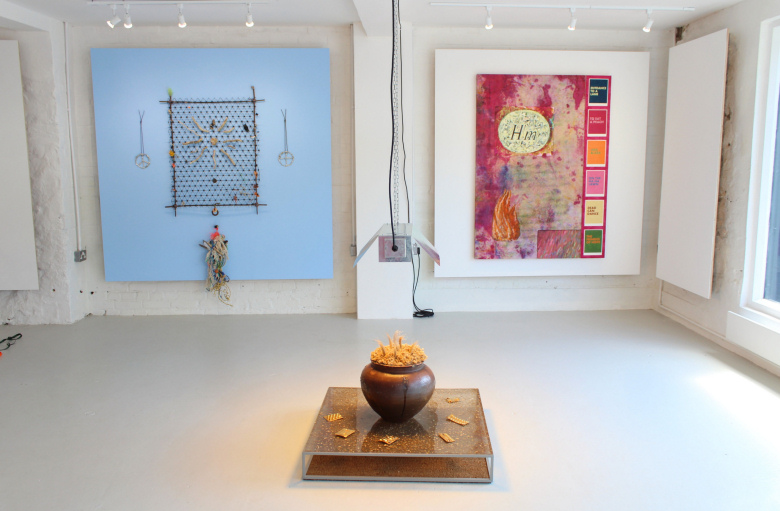
(On wall) Work by Tom Sewell and Dan Howard-Birt, and
(on floor) Steven Claydon
Every part of Abigail Reynolds’s
contribution seems to have had a life elsewhere before being brought
into the conceptual space of 'The Maidens'. Put differently, the piece
is a composite of objects manufactured by others with no thought of
being in this artwork. Several decades ago, such a manoeuvre by the
artist would have been transgressive; further back in the last century,
it would have been deemed unacceptable behaviour. The world has moved on
and art with it so that Reynolds’s method is as mainstream as the
current heterogeneous art world can manage. That opinion does not
express scepticism because every element, imported though it is, is
integral to this artwork’s being. It is another form of repurposing.
From first encounter the collection of geometric shapes – books,
tabletop, table stand; two interconnected rectangular frames, a
perforated metal grille and the neat that keeps the open pages of one
book from folding shut – emits significance that requires investigation.
Firstly, the assemblage feels modern, in that mid-last century way of
Isokon Flats architecture and Mies’s furniture. Then that sensation
carries on to the rectangular reproductions in the book pages opened to
view; they are not colour photographs but elderly monochrome. The books
themselves are not new but date back at least forty years. Yet the
images the artist directs attention the viewer to are, in some way, what
is now called ‘iconic’.
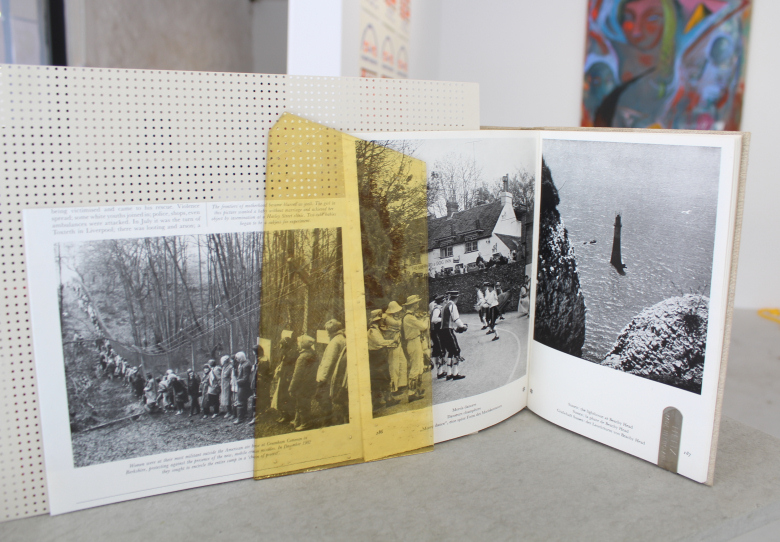
Abigail Reynolds: The Maidens (detail)
They depict gatherings of one sort or
another. Reading from the left, as people tend to do, the anoraked and
booted women lining a tall perimeter fence instantly mean Greenham
Common to viewers of a certain age. The location defined an era of
division in British history. The next image has morris men dancing for
an audience which sits atop a wall fronting a pub, a thatched building
with a steep gable below which its name plus ‘inn’ is legible, all
symbolic details of an image England has cultivated about its stability
- traditions that have leeched into a nation’s vision of itself of
settled social structures, leavened by innocent good humour and
untainted by dissent. Reynolds also gives exposure to the cover of the
book in which this picture appears. Round the back, blocked in red
capitals on the solid grey cloth of its stout binding, is one word,
‘England’, spelled out in red characters with Biblical assurance.
Next to the morris men, on the facing page, is the lighthouse at Beachy
Head. It may or may not be part of this work but an accident of
publishing that could not be hidden. To assess this possibility is also
to realise how politicised England’s image of itself has become. The
lighthouse can be interpreted as another symbol of island identity, the
stoic guardian of life and shore alert to threats that come from across
the sea, from ‘out there’. Moreover, that structure is as erect as a
bear-skinned guardsman on duty with more than a little phallic swagger.
Turning corner of the table, reveals the last of the images, on a page
open from another book, a mid last-century guidebook to Cornwall. The
caption identifies the stone circle as The Merry Maidens, the Bronze Age
site at Boleigh.
There is seriousness about this grouping of objects and images. The
general tone is a sober cream and black, with colour muted into discrete
patches - the outline of cherry red in the guidebook’s binding, the
block of oatmealy grey from the other hardback cover and a shard of
mustard yellow supplied by a roughly shaped piece of glass. It is
propped up against the first two images, bridging them; it is the kind
of glass that distorts appearances. The profile of the ensemble is
noticeably angular, even edgy: it sets the tone for its reception. The
Maidens could almost be a maquette for a modernist memorial, raised up
on a plinth for easier viewing but with its purpose undisclosed.
Stringing elements together, therefore, is the core of the narrative
process. The women’s peaceful and defiant action at Greenham, which was
to continue for 19 years until it became a symbol of its own dedication,
was routinely belittled by the right-wing press, as much for daring to
disrupt the cherished image of women as homemakers and mothers as for
opposing the controversial government policy to site US cruise missiles
at airbases during one of the chilliest periods of the Cold War.
The Greenham women held hands to link themselves together as a human
blockade preventing the weapons from being driven into the base. (As a
result, they had to be airlifted at great cost.) Hands link and circles
form in morris dancing, an activity that defends another symbol, the
male preserve. Though that citadel is slowly crumbling, to purists, the
involvement of women is sacrilege, as a report in the Guardian newspaper
made plain as recently as 2019. The final paragraph of this tale is
supplied by the stone circle, to which all manner of fables have been
concocted about its origin, mostly by Victorians who were masters of
invented history and instant moralising folklore. From that time rose
the story that the stones were local girls who defied the Sabbath by
dancing and were punished by being turned to stone.
The myth survives, built on a characteristic misunderstanding of the
site’s Cornish name, ‘Dans Meyn’. Academics claim the words refer not to
dancing but only to the place being sacred for its pagan builders.
Still, the image closes a circle of meaning: the pervasive denigration
of women by authority, political, cultural or social, that is dominated
by men as their preserve. Is misunderstanding itself a credible theme of
this work? Or the need for vigilance? The work was completed in 2012
(and the oldest piece in this show; the others date from 2020-1) and
seems to be ahead of events. Brexit with that aspect of harking back to
a past that never quite was, had yet to happen and the #MeToo movement
was still to coalesce.
The value of this work, and the others in this show, is that they mine
our current reality as raw material for imaginary world building. In
Steven Claydon’s 'Playerless Games (Kamidana)', that world resembles the
scene after a gathering, the remains of a swanky party involving pills
at a place where the furniture has the finish of a well-maintained
holiday tan. The trigger for any interpretation is the glass-topped
structure under and over which the other elements are arranged. The
open-sided low metal base could be the height-challenged cousin of
Reynolds’s nearby construction. Rising no more than shin height, it
resembles an urban coffee table with carpet neatly contained beneath; on
top is a circular, broad-waisted earthenware jar containing dried
flowers. The glass top also harbours blister packs of the type
immediately associated with pharmaceuticals: many of the thermoformed
plastic pillows have been pushed through and emptied. A dusting of
pollen-fine powder, also golden, frames the table’s perimeter.
Illuminating this display is the strong bulb in the overhead lamp, slung
low by cables hanging from the ceiling.
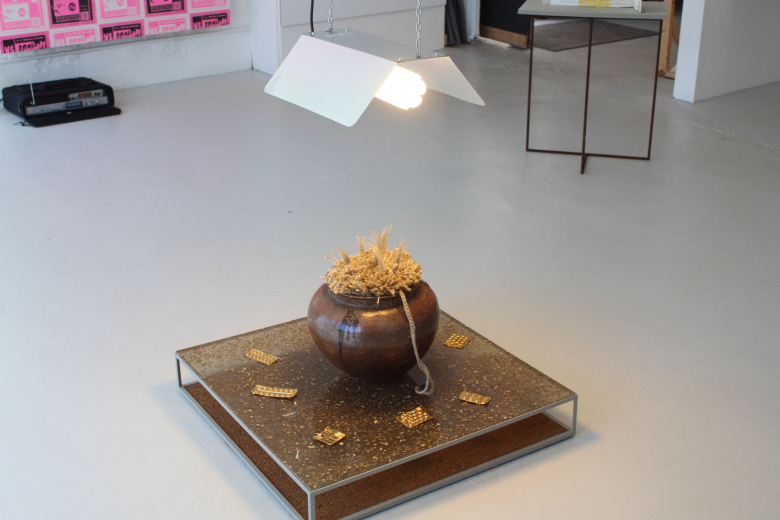
Steven Claydon: Playerless Games
The scene could also be a pictogram for the word ‘aftermath’: after an
event, after people (sensed as having been present) have gone, after a
crime, even. The onlooker’s eyes dust the evidence for clues to the
story. While sifting the evidence, the basis of this initial, cynical
assessment starts to crumble. Or alternative routes open that introduce
unsuspected multivalence to this concentrated, intense scenario. The
assumption, fuelled by the high-roller gilding of the sitting-room
apparel, is that the packs, which the gallery notes list as ‘nine carat
gold plated copper’, may have dispensed psychoactive substance that
transported their consumers into an alternative headspace nirvana. Was
the aim of the ‘game’ in the title to satisfy needs unmet by material
excess? What is cultivated in the jar that calls for hydroponic light
still lit in daytime? The mind begins to inhale notions of modern
equivalents of the island lotus-eaters of classical mythology, indulging
in pleasure and luxury as an escape from practical concerns. The setting
of this peaceful apathy, however, is more like Canary Wharf than Grays
Wharf.
As with the other participants in 'Gathering', Claydon has provided a
work that articulates continuing themes in his practice. The clash of
artefacts and the diverse eras they come from has established itself as
a theme in his sculpture. Time and origin are bent almost to the point
of irrelevance, stripping an object back to its banal thingness – a fact
made up of properties: shape, scale, colour, surface. These details are
put on display and assessed as commodities of meaning and nothingness at
the same time. The combination, however, asks many questions: about the
nature of the dust, the reason for the packs, the jute of the matting
and the language of the title. At which point, Claydon appears drawn to
the risk of obscurity with the perceived demand his installations make
for specialist knowledge. The viewer feels pulled beyond that barrier of
difficulty by the natural desire to comprehend, to construct a credible
picture of overall significance, to resolve the dilemma. Claydon infers
the truism that full ‘understanding’ is an unattainable in artwork; even
its creator is denied it. As in everyday life, the gaps in certainty are
either acceptable or bridged by speculation, which is where narrative
arises.
‘Kamidana’ is not a word known to many in the west but is familiar in
Shinto households. As the indoor shrine, it is home to the ‘kami’,
spiritual holy powers. Ancient community ancestors are among these
deities, and because they co-exist with living in nature, they might
embody the values and virtues that those ancestors exhibited when living
ranging from good to evil. Knowledge assembled elsewhere in this show
throws a line to anyone beginning to thrash about for relevance in these
esoterica. The supposed presence of deities has been encountered often
enough already to apply that dimension here, even if help in making good
of it is less forthcoming. The gallery notes refer to the jar as
‘Momayama period’, which is the Japanese equivalent of late medieval in
European terms and to ‘tufts or flames from Tregeseal stone circle’ (as
well as to shredded money in resin’) among the components of this work.
Tregeseal belongs to yet another time: it is another ancient site in
west Cornwall, not far from St Just. Some academics claim that these
circles were devoted to the dead, like a sort of monolithic, open,
outdoor ‘kamidana’ or shrine. That view is disputed but consensus
appears to exist that the stones were reserved for supernatural
entities.
The formal cohesion of 'Playerless Games (Kamidana)' is matched by its
tactically diffuse references. The route into this captivating conundrum
arises solely from the artist’s choice of objects to put in one place
and held in that place by light (with all its connotations) and the
invitation to view the piece in whole and part. The piece exudes
confidence in itself and its inscrutability, factors evident elsewhere
in Gathering which contribute to the show’s admirable openness to the
viewer’s imagination. Another feature of the show is the relationship
between unconnected works by 10 artists known to the selectors and who
share Cornwall as a common denominator. Birt and Sewell are the newest
arrivals in the predominantly rural west of the county and their work is
no less representative of a collective fascination with the specific
topography of the region. To a fair extent, this group came together
because of that shared interest. Along with its recent art history, the
Cornish heritage of myths and rituals has for decades been a mixed
blessing, and almost a prerequisite, for artists working locally,
providing the groundwork for and handicap to their serious progression
beyond a stifling parochialism to higher levels of dialogue. The artists
gathered here appear to have survived its worst aspects, linking with
its broader cultural and social importance in the interconnecting energy
of the universe.
'Gathering' at Grays Wharf, Penryn, 28 May-13 June
2021, was organised by Jonathan Michael Ray and Verity Birt.
© Martin Holman 2021. The author is a writer based in Penzance and a
regular contributor to Art Monthly and the Burlington Magazine.
See
http://www.artcornwall.org/exhibitions/Grays_Wharf/Gathering.htm for
more installation shots.
14.7.21 |









